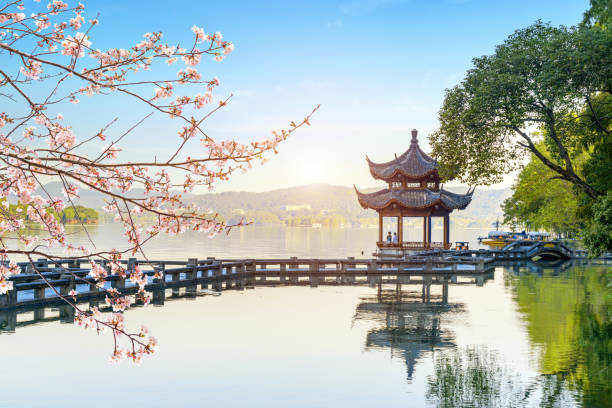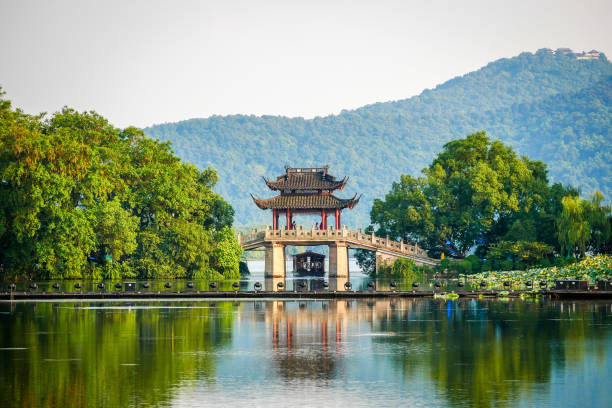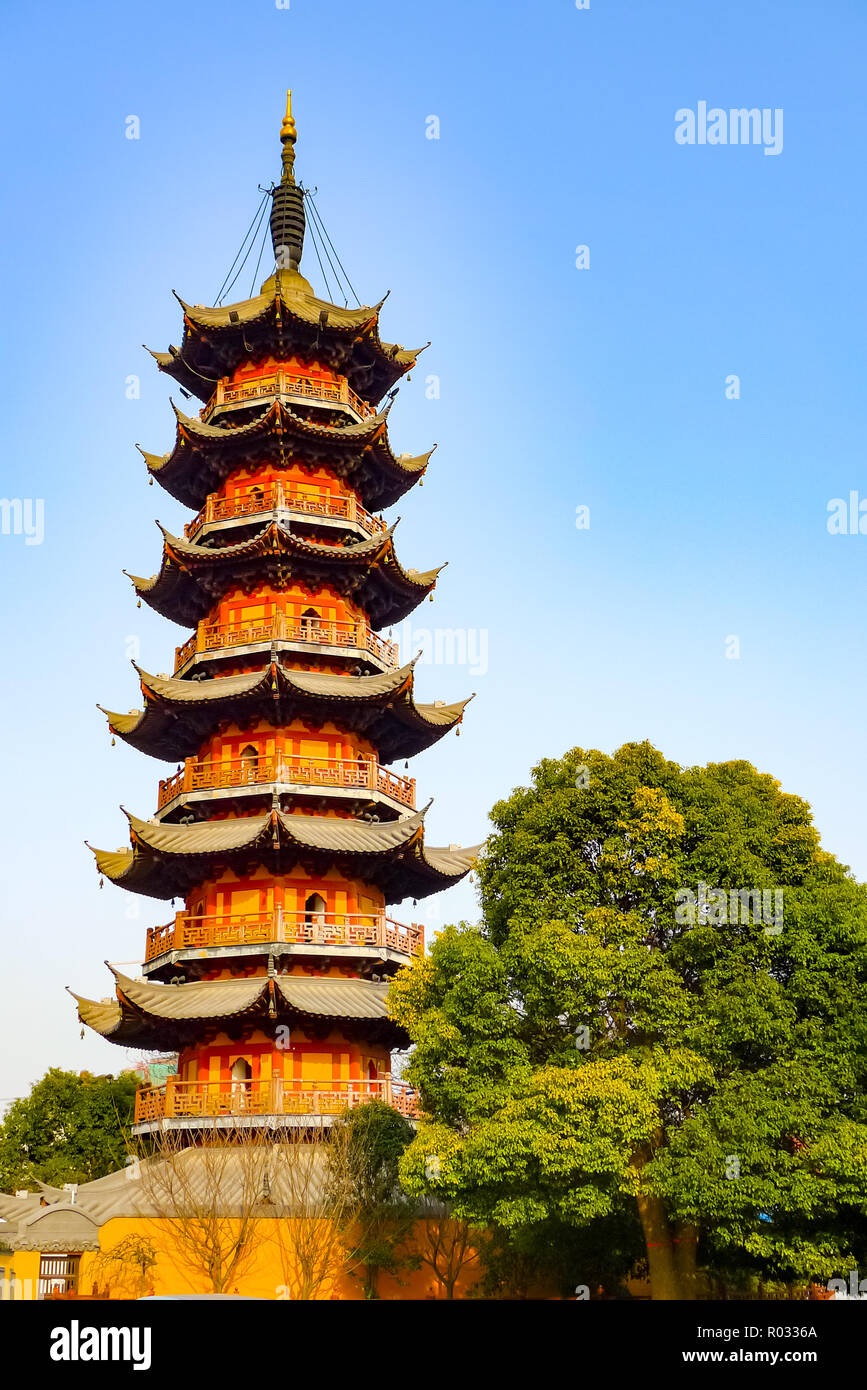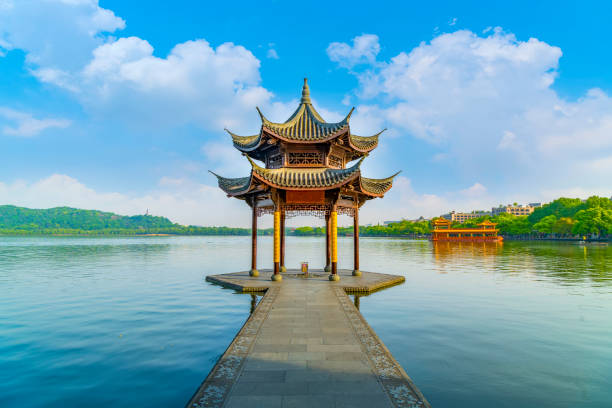Photography Tips for Capturing the Beauty of Longhua Pagoda and Temple

An Essential Guide to Visiting Longhua_Pagoda_And_Temple
Nestled in the heart of Shanghai’s bustling Xuhui District, Longhua Pagoda and Temple stand as a serene testament to the city’s rich cultural heritage. With a history that stretches back over 1,700 years, this ancient complex invites travelers to step back in time and immerse themselves in the tranquil world of Buddhism. First constructed during the Three Kingdoms period in 242 AD, the Longhua Temple is not only the oldest temple in Shanghai but also the largest, sprawling across an impressive 20,000 square meters.
As you wander through the meticulously designed courtyards and halls, you will encounter an exquisite blend of architectural beauty and spiritual significance. The iconic Longhua Pagoda towers above the temple grounds, its seven stories gracefully ascending into the sky, beckoning visitors to explore its intricate wooden staircases and delightful eaves adorned with melodic bells.
Beyond its architectural splendor, Longhua Temple is a vibrant cultural hub, hosting annual events such as the famous New Year Bell-Striking Ceremony—a unique experience that draws locals and tourists alike. Whether you’re seeking spiritual solace, a glimpse into Shanghai’s storied past, or simply a peaceful escape from the city’s hustle and bustle, a visit to Longhua Pagoda and Temple promises an unforgettable journey into the heart of Chinese tradition. So lace up your walking shoes and prepare to uncover the magic of this historical gem!
In This Guide
- An Essential Guide to Visiting Longhua_Pagoda_And_Temple
- The Rich History and Legends of Longhua_Pagoda_And_Temple
- Main Highlights: What You Absolutely Can’t Miss
- Planning Your Visit: A Practical Guide
- Tickets: Prices, Booking, and Tips
- How to Get There: A Complete Transportation Guide
- Local Cuisine and Accommodation Nearby
- Frequently Asked Questions
- Final Thoughts on Your Trip
The Rich History and Legends of Longhua_Pagoda_And_Temple
Nestled in the bustling Xuhui District of Shanghai, the Longhua Pagoda and Temple stand as a testament to the city’s rich historical tapestry. With roots tracing back to 242 AD during the tumultuous era of the Three Kingdoms, Longhua Temple is not only the oldest temple in Shanghai but also one of its largest, sprawling across an impressive 20,000 square meters. This sacred site has witnessed the ebb and flow of time, enduring numerous reconstructions due to the ravages of war, particularly during the Qing Dynasty under the reigns of Emperor Tongzhi and Guangxu.
The temple’s name, “Longhua,” is steeped in legend. According to local folklore, it is derived from a mythical tree known for its extraordinary size—its branches purportedly stretched for 20 kilometers. It is said that beneath this tree, the Maitreya Buddha attained enlightenment, adding a spiritual significance that resonates deeply with visitors.
Architecture enthusiasts will appreciate the carefully planned layout of the temple, which follows traditional Buddhist symmetry. The axis of the complex is lined with significant halls, including the Maitreya Hall, Devajara Hall, and the majestic Mahavira Hall, each exuding an aura of serenity and reverence. The centerpiece, Longhua Pagoda, rises 40.4 meters high with its seven stories tapering elegantly toward the sky. Constructed primarily from brick, it features wooden staircases, and each tier is adorned with delicate balconies and the cheerful sounds of bells, a hallmark of its design that continues to charm visitors.
Longhua Temple is not just a place of worship but also a vibrant cultural hub. Every year, it plays host to the New Year Bell-Striking Ceremony, an event that draws both locals and tourists. The ceremony features a grand copper bell, two meters tall and weighing over five tons, which tolls melodiously to herald the arrival of the New Year. This celebration is one of the eight great attractions of Shanghai, encapsulating the spirit of renewal and hope.
As spring arrives, the temple transforms into a lively spectacle, particularly during the temple fair held on the 3rd of March in the lunar calendar. Visitors flock to witness the stunning peach blossoms that adorn the park, creating a picturesque backdrop for cultural festivities.
For international travelers, a visit to Longhua Pagoda and Temple offers a unique glimpse into Shanghai’s spiritual heritage and architectural grandeur. The harmonious blend of history, legend, and culture makes this site a must-explore destination, ensuring that every visitor leaves with a deeper appreciation for the city’s profound legacy.

Longhua_Pagoda_And_Temple.
Main Highlights: What You Absolutely Can’t Miss
Longhua Pagoda and Temple, nestled in the heart of Xuhui District, is a treasure trove of history and spirituality that no traveler should miss when visiting Shanghai. With over 1,700 years of rich heritage, this site is not just the oldest temple in the city, but also the largest, occupying an impressive area of more than 20,000 square meters. Here are the key highlights that make Longhua Pagoda and Temple an essential stop on your Shanghai itinerary.
1. The Majestic Longhua Pagoda
Standing tall at 40.4 meters, the Longhua Pagoda is a stunning seven-storied structure that showcases the architectural brilliance of the Song Dynasty. Each level, slightly smaller than the one below, is adorned with delicate balconies and charming eaves that chime with the wind. As you ascend, take in the serene atmosphere and the panoramic views of the surrounding gardens and temples.
2. The Ancient Longhua Temple
Founded in 242 AD, the Longhua Temple is a sanctuary of peace and devotion. The temple complex features multiple halls, including the Mahavira Hall, which houses a magnificent statue of the Sakyamuni Buddha, and the Maitreya Hall, dedicated to the Future Buddha. The intricate carvings and vibrant murals throughout the temple tell stories of Buddhist teachings and history, inviting visitors to explore and reflect.
3. New Year Bell-Striking Ceremony
If you happen to be in Shanghai during the New Year, don’t miss the Evening Bell-Striking Ceremony. At the stroke of midnight on December 31st, a massive copper bell weighing five tons rings out, welcoming the new year with melodic vibrations that resonate throughout the temple grounds. This ritual is a cherished tradition and offers a unique cultural experience that is both spiritual and festive.
4. The Beautiful Courtyard and Gardens
The temple complex is not just about the buildings; the courtyards and gardens are equally mesmerizing. Stroll through the serene landscapes filled with peach blossoms in late spring, creating a picturesque backdrop for reflection and photography. The seasonal temple fair, held on the 3rd of March in the lunar calendar, attracts numerous visitors, adding to the vibrant atmosphere.
5. Architectural Symmetry and Cultural Significance
The layout of Longhua Temple is a prime example of traditional Chinese architectural symmetry, emphasizing balance and harmony. The Bell Tower and Drum Tower, flanking the main halls, are architectural highlights that enhance the temple’s beauty. These structures are not just functional but symbolize the interconnectedness of time and faith in Buddhist culture.
6. Easy Access and Visitor Information
Reaching Longhua Temple is straightforward. You can take Metro Line 11 or 12 to Longhua Station, followed by a short walk. Alternatively, various bus routes also serve the area. The entrance fee is a modest CNY 10, making it an accessible destination for all travelers. The temple is open daily from 7:10 AM to 4:30 PM, with extended hours on specific lunar dates.
Conclusion
A visit to Longhua Pagoda and Temple is not just an exploration of ancient architecture; it’s an immersion into the spiritual heart of Shanghai. Whether you seek tranquility, cultural enrichment, or simply a beautiful setting to unwind, Longhua offers a remarkable experience that captures the essence of this vibrant city. Don’t forget your camera and an open heart as you delve into the serene beauty of this historical gem.

Longhua_Pagoda_And_Temple.
Planning Your Visit: A Practical Guide
Planning Your Visit to Longhua Pagoda and Temple
Longhua Pagoda and Temple, nestled in the heart of Shanghai’s Xuhui District, is a breathtaking testament to over 1,700 years of history and culture. As the oldest and largest temple in the city, it offers international travelers a unique glimpse into the rich tapestry of Chinese heritage. Here’s everything you need to know to make the most of your visit.
Getting There
Public Transport:
– Metro: The easiest way to reach Longhua Temple is via Shanghai Metro. Take Line 11 or Line 12 to Longhua Station. After exiting at Exit 2, head north along Longhua Road. The temple will be on your right after a short walk.
– Bus: Several bus routes service Longhua Temple, including numbers 41, 44, 56, and 104. Disembark at Longhua Station for easy access.
Entrance Fee and Hours
- Entrance Fee: CNY 10 (approximately $1.50).
- Special Events: The New Year Bell-Striking Ceremony, held from 9:00 PM on December 31 to 2:00 AM on January 1, costs CNY 120 ($18) to attend.
- Opening Hours: Open daily from 7:10 AM to 4:30 PM; during the 1st and 15th days of the first lunar month, hours extend to 5:00 PM.
Ideal Duration
Plan to spend around 1.5 hours at Longhua Temple. This allows ample time to explore the various halls, admire the exquisite architecture, and take part in any ceremonial events if your visit coincides with special occasions.
What to See
- Longhua Pagoda: Standing at 40.4 meters, this seven-storied pagoda is an architectural marvel, featuring a brick body and wooden staircases. Each tier is adorned with beautiful balconies and lively bells that chime with the wind.
- Temple Halls: Wander through the various halls, including the Mahavira Hall, which houses impressive Buddhist statues, and the Sutras Keeping Hall, where sacred texts are preserved.
- Evening Bell-Striking Ceremony: If visiting around New Year’s, don’t miss this iconic event, which is said to usher in good fortune for the year ahead.
- Peach Blossoms: If you visit in late spring, the temple grounds are a sight to behold as peach blossoms bloom, attracting numerous visitors and pilgrims.
Nearby Attractions
While Longhua Temple is a gem in its own right, consider exploring other nearby attractions to enhance your visit:
– Shanghai Museum: A treasure trove of ancient Chinese art and artifacts.
– Jade Buddha Temple: Known for its stunning jade sculptures and peaceful atmosphere.
– Zhujiajiao Water Town: A charming ancient town with canals and traditional architecture, perfect for a day trip.
Tips for Your Visit
- Dress Appropriately: As this is a place of worship, dress respectfully. Comfortable shoes are recommended for walking around the temple grounds.
- Photography: Feel free to take photos; however, be mindful of areas where photography may be prohibited, especially during ceremonies.
- Cultural Etiquette: If you wish to participate in any rituals, such as lighting incense, approach with respect and follow the local customs.
With its historical significance and architectural beauty, a visit to Longhua Pagoda and Temple promises to be a memorable highlight of your trip to Shanghai. Enjoy your journey through this serene slice of history!

Longhua_Pagoda_And_Temple.
Tickets: Prices, Booking, and Tips
When planning your visit to the Longhua Pagoda and Longhua Temple, knowing the ticket prices and booking options can help enhance your experience at this historic site. Here’s what you need to know:
Ticket Prices
-
General Admission: The entrance fee to Longhua Temple is CNY 10 (approximately $1.50), making it an affordable destination for travelers.
-
New Year Bell-Striking Ceremony: If you wish to participate in the enchanting Evening Bell-Striking Ceremony held on December 31st, tickets are priced at CNY 120. This special event runs from 9:00 PM on December 31 to 2:00 AM on January 1, offering a unique way to ring in the New Year.
Opening Hours
Longhua Temple is open daily from 7:10 AM to 4:30 PM. However, on the 1st and 15th days of the first lunar month, the temple opens earlier at 5:00 AM and maintains the same closing time. This early opening allows visitors to enjoy the temple’s serene atmosphere during special lunar celebrations.
Recommended Visit Duration
Plan to spend approximately 1.5 hours exploring the site. This timeframe will give you enough opportunity to soak in the rich history, admire the impressive architecture, and perhaps participate in a small prayer or reflection.
Getting There
To reach Longhua Temple, you have a couple of convenient options:
-
By Metro: Take Metro Line 11 or Line 12 to Longhua Station. From exit 2, follow Longhua Road, turn north at the crossing, and continue along West Longhua Road to find the temple.
-
By Bus: Several bus lines serve the area, including 41, 44, 56, 87, and many others. Simply disembark at Longhua Station.
Booking Tips
-
Advance Tickets: While general admission tickets can be purchased on-site, consider booking for the New Year’s ceremony in advance due to its popularity. This ensures your spot for a memorable experience.
-
Guided Tours: If you’re interested in a more in-depth exploration, numerous guided tours are available that include Longhua Temple in their itineraries. These usually offer insights into the temple’s history and significance, enriching your visit.
-
Cultural Events: Keep an eye on local festivals and events, such as the Longhua Temple Fair, which celebrates the arrival of spring and features traditional performances and food stalls. Attending during these times can enhance your experience.
Visiting Longhua Pagoda and Temple not only offers a glimpse into Shanghai’s spiritual heritage but also provides a peaceful retreat from the bustling city. Don’t miss the opportunity to immerse yourself in the tranquility of this ancient site!
How to Get There: A Complete Transportation Guide
Reaching Longhua Pagoda and Temple is both straightforward and convenient, thanks to Shanghai’s efficient public transport system, making it an accessible destination for international travelers eager to explore this historic site.
By Metro
The fastest way to reach Longhua Temple is via the Shanghai Metro. You can take either Metro Line 11 or Line 12. Here’s what you need to do:
- Board the Metro: Depending on your starting location, locate the nearest metro station that services Line 11 or Line 12.
- Disembark at Longhua Station: After a comfortable ride, get off at Longhua Station.
- Exit the Station: Take Exit 2 from the station.
- Walk to the Temple: From the exit, stroll along Longhua Road until you reach a crossing. Turn north and continue walking along West Longhua Road. You’ll soon see Longhua Temple on your left, nestled along Longhua Old Street.
By Bus
For those preferring bus travel, there are numerous bus routes that will take you close to Longhua Temple. Here are the bus lines you can take:
- Bus Numbers: 41, 44, 56, 87, 104, 120, 144, 166, 167, 178, 301, 326, 342, 714, 720, 733, 734, 770, 809, 824, 831, 864, 932, 933, 956, and 957.
- Get Off at Longhua Station: Board any of these buses and alight at the Longhua Station bus stop. From there, it’s just a short walk to the temple.
Bicycle and Walking
If you’re in the mood to soak in the local atmosphere, cycling or walking can be delightful options, especially since Longhua Temple is located in a beautiful area adorned with peach blossoms in the spring.
- Biking: Several bike-sharing services operate throughout Shanghai. Simply find a bike near your location, ride to Longhua Temple, and park it at one of the designated bike racks.
- Walking: If you’re staying nearby or exploring the Xuhui District, Longhua Temple is a pleasant destination to walk to, allowing you to enjoy the local sights along the way.
Taxi Services
For those who prefer a direct and private mode of transport, taxis are widely available. Just tell the driver:
- Destination: “Longhua Si” (龙华寺) or provide them with the address: No. 2853, Longhua Road, Xuhui District.
- Ride Share Apps: Alternatively, you can use ride-sharing apps like Didi, which are popular in China.
Entrance Fees and Hours
- Entrance Fee: CNY 10 (approximately $1.50) for general admission.
- Special Event Fee: CNY 120 for the New Year Bell-Striking Ceremony (held from 9 PM on December 31 to 2 AM on January 1).
- Opening Hours: Daily from 7:10 AM to 4:30 PM (with extended hours on the 1st and 15th of the lunar month, opening at 5:00 AM).
Recommended Visit Duration
Plan to spend about 1.5 hours exploring the serene grounds and historical architecture of Longhua Temple and Pagoda.
By following these transportation tips, you’ll find it easy to visit Longhua Pagoda and Temple—an essential stop for anyone interested in the rich cultural tapestry of Shanghai. Safe travels!

Longhua_Pagoda_And_Temple.
Local Cuisine and Accommodation Nearby
When visiting the Longhua Pagoda and Temple, immerse yourself in the rich culinary traditions of Shanghai and discover comfortable accommodations nearby to enhance your travel experience.
Local Cuisine
-
Vegetarian Delights at Longhua Temple Vegetarian Restaurant
Located within the temple grounds, this restaurant serves a variety of delicious vegetarian dishes inspired by Buddhist traditions. Enjoy dishes like Buddha’s Delight, vegetable dumplings, and various tofu preparations, all crafted to nourish both body and spirit. -
Authentic Shanghai Cuisine at Nanxiang Steamed Bun Restaurant
Just a short distance from Longhua Temple, Nanxiang is renowned for its xiaolongbao (soup dumplings). These delicate dumplings are filled with juicy pork and a savory broth, making for a must-try dish that encapsulates the essence of Shanghai’s culinary scene. -
Street Food at Longhua Old Street
Stroll along Longhua Old Street, where you can sample local street food favorites. Grab a baozi (steamed bun), some spicy scallion pancakes, or a bowl of hot and sour soup from one of the many vendors lining the street. This is a great way to experience the hustle and bustle of local life while enjoying tasty bites. -
Sichuan Spice at Chuan Ban
If you’re in the mood for something with a kick, head to Chuan Ban, which specializes in Sichuan cuisine. Enjoy mouthwatering dishes like mapo tofu and spicy hot pot, perfect for those who enjoy bold flavors and a bit of heat.
Nearby Accommodations
-
Longhua Hotel (龙华酒店)
Located just a short walk from Longhua Temple, this hotel offers comfortable rooms with modern amenities. Enjoy a peaceful stay in a serene environment while being close to one of Shanghai’s historical landmarks. -
Renaissance Shanghai Zhongshan Park Hotel
Situated about 10 minutes away by taxi, this upscale hotel features stylish rooms, a fitness center, and an on-site restaurant serving international cuisine. With its central location, it’s an excellent base for exploring the city. -
Hanting Hotel Shanghai Longhua
For budget-conscious travelers, this hotel offers clean and simple accommodations without breaking the bank. It’s conveniently located near public transport, making it easy to explore both Longhua Temple and other attractions around Shanghai. -
Grand Mercure Shanghai Hongqiao
This hotel provides a blend of comfort and convenience with well-appointed rooms, a fitness center, and a restaurant that serves both local and international dishes. It’s a great choice for travelers looking for a more luxurious experience while remaining within easy reach of Longhua Temple.
Whether you’re savoring local dishes or resting in comfortable accommodations, your visit to Longhua Pagoda and Temple will be enriched by the flavors and hospitality of Shanghai.

Longhua_Pagoda_And_Temple.
Frequently Asked Questions
Frequently Asked Questions
1. What is the history of Longhua Temple?
Longhua Temple, built in 242 AD during the Three Kingdoms period, is the oldest temple in Shanghai, boasting a remarkable history of over 1,700 years. Although the temple has faced several destructions due to wars, much of its current structure was reconstructed during the Qing Dynasty.
2. Where is Longhua Temple located?
You can find Longhua Temple at No. 2853, Longhua Road, in the Xuhui District of Shanghai. It is easily accessible via public transport.
3. How do I get to Longhua Temple using public transportation?
To reach Longhua Temple, take Metro Line 11 or Line 12 and disembark at Longhua Station. From there, exit through Exit 2 and walk along Longhua Road. Several bus lines also service the area, including routes 41, 44, 56, and many more.
4. What are the entrance fees and opening hours?
The entrance fee for Longhua Temple is CNY 10. For special events like the New Year Bell-Striking Ceremony, the fee is CNY 120. The temple is open from 7:10 AM to 4:30 PM daily, with extended hours on the 1st and 15th days of the lunar month, where it opens at 5:00 AM.
5. What should I expect during the New Year Bell-Striking Ceremony?
The Evening Bell-Striking Ceremony on December 31 is a significant event where a huge copper bell is struck to welcome the New Year. The ceremony is renowned for its melodious sound, creating a memorable experience for participants.
6. How long should I plan to visit Longhua Temple?
A visit to Longhua Temple typically takes around 1.5 hours. This should give you sufficient time to explore the various halls, admire the architecture, and soak in the tranquil atmosphere.
7. Are there any festivals or special events I should know about?
Yes! The Longhua Temple Fair, held on the 3rd day of the lunar calendar, attracts many visitors with its vibrant celebrations, cultural performances, and delicious local snacks. Late spring is also a beautiful time to visit, as the peach blossoms in Longhua Park are in full bloom.
8. Is there any etiquette I should follow while visiting the temple?
As Longhua Temple is a place of worship, it’s advisable to dress modestly and maintain a respectful demeanor. Feel free to observe rituals, but be sure to follow any posted guidelines and avoid disturbing worshippers.
Final Thoughts on Your Trip
As you conclude your visit to the Longhua Pagoda and Temple, take a moment to reflect on the rich tapestry of history and spirituality that envelops this remarkable site. With over 1,700 years of stories etched into its ancient walls, Longhua Temple stands not just as a testament to the resilience of cultural heritage, but also as a serene sanctuary amidst the hustle and bustle of modern Shanghai.
Whether you were captivated by the melodious tones of the Evening Bell-Striking Ceremony, enchanted by the intricate architecture of the pagoda, or simply enjoyed a peaceful stroll through Longhua Park’s vibrant peach blossoms, each experience contributes to the essence of this sacred space.
As you prepare to head to your next destination, carry with you the tranquility and inspiration found in Longhua’s sacred grounds. Allow the echoes of the past and the beauty of the present to inspire your journey onward, reminding you that in every corner of the world, there are stories waiting to be discovered—stories that connect us all through time, culture, and shared humanity.